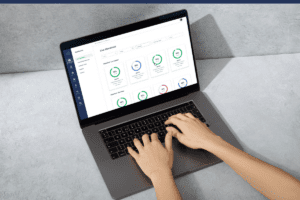The Importance of Documenting Student Interaction in Distance Learning Courses for Career Institutes
New Department of Education regulations coming into effect on July 1 define regular and substantive interaction and academic engagement in distance learning courses. Documenting student interaction will help career-focused institutes stay compliant and create a strong audit trail.
On July 1, regulation changes for career institutes go into effect, including an updated definition of distance education. The first piece of the new definition is simple—distance education uses “one or more types of technology including the internet, various wired and wireless media, or audio conferencing.”
The second piece is where it gets more complicated. According to the new definition, distance education also “supports regular and substantive interaction between the students and instructor/instructors, synchronously or asynchronously.” Fortunately, ED also gave us the definition of both “regular” and “substantive” interaction, so compliance leaders aren’t kept guessing—more on that later.
Alongside the updated definition of distance education comes an updated definition of academic engagement, requiring “active participation by a student in an instructional activity related to the student’s course of study.”
- Academic engagement includes:
- Attending a class where the student and instructor interact, like a synchronous course.
- Turning in an academic assignment
- Participating in an interactive computer-assisted instruction
- Participating in an institutional-directed group activity or online discussion
- Interacting with the instructor regarding academic matters
- Academic engagement does NOT include:
- Living in institutional housing or participating in a meal plan
- Logging into an online class without further participation
- Participating in academic counseling or advising
The definition of academic engagement is clear; a student simply logging on isn’t enough. Schools must track and document participation in distance education courses to ensure compliance. Read on to learn more about how your school can document interaction for a clear audit trail.
Documenting substantive interaction to ensure compliance in distance learning courses
Under the definition of “substantive interaction,” instructors must engage students in “teaching, learning, and assessment consistent with the content under discussion.” Engagement must come from at least two of the five following components:
Providing direct instruction in distance education courses
This piece is second nature for every instructor. One way that instructors provide direct instruction in distance learning programs is through synchronous courses held with video conferencing software where they engage with students directly as they would in class. Unfortunately, due to the nature of distance learning, it’s difficult for instructors to watch every student at once and ensure they’re remaining engaged. New technology helps instructors conduct polls during synchronous courses to facilitate engagement and check for understanding. This technology provides schools with a record of which students completed the poll questions, proving to auditors that students were engaged during the lesson even if the students were not on-ground. If a student routinely does not answer questions, instructors can intervene, keeping the student engaged and on track.
Assessing or providing feedback on a student’s coursework in distance education courses
Fortunately, this part is also a no-brainer for instructors, but it does take significant instructor time. Whether it’s papers, tests, or other projects, instructors diligently grade every piece of coursework, then input that information into the LMS or the SIS for compliant documentation.
One way to lessen the burden on instructors and ensure feedback is promptly documented in the SIS is to leverage auto-graded assessments. Instructors no longer have to sort through every multiple choice answer one by one and can instead provide higher-value feedback on projects and papers. Students receive real-time feedback to help them understand what concepts they’ve mastered and what concepts they need to study further.
Providing information or responding to questions about the content of a course or competency
Outside of synchronous class time, email is one of the most common ways for students to communicate with their instructors, yet it leaves schools susceptible to compliance issues.
Let’s face it, when it comes to email, there are two types of people in this world, inbox zero and inbox three-hundred. If one of your instructors is the latter and is delayed in responding to student questions, your school is at risk of failing to meet requirements for regular and substantive interactions. Under the definition of regular interaction (more on that below), the institution shoulders the responsibility for ensuring that an instructor promptly and proactively responds to student requests. Empowering instructors with technology that has a dedicated inbox for instructor/student communications ensures that no student question gets lost. Plus, instructor inboxes give your school a time-stamped record of every interaction in one place.
Facilitating a group discussion regarding the content of a course or competency
Synchronously, instructors can facilitate a group discussion via video conferencing software. Unfortunately, synchronous video discussions run into similar problems as in-person discussions, like some students not speaking up while others dominate the conversation. Many schools utilize an LMS with a discussion board where students can post their thoughts, then click around the board and respond to other students. Where discussion boards fall short is real-time interaction. Live chatrooms help students receive real-time interaction with their peers while empowering quieter students to share their thoughts and ask questions. In addition, instructors and administrators can access chat logs as proof of substantive interaction.
Other instructional activities approved by the institution’s or program’s accrediting agency
If an instructor has a unique idea for keeping students engaged during distance learning courses, connect with your accreditor to ensure your school remains compliant.
Documenting regular interaction to ensure compliance in distance learning courses
Regular interaction requires an institution to ensure “opportunity for substantive interactions with the student on a predictable and scheduled basis commensurate with the length of time and the amount of content in the course or competency” before course completion. The institution is responsible for “[m]onitoring the student’s academic engagement and success and ensuring that an instructor is responsible for promptly and proactively engaging in substantive interaction with the student when needed on the basis of such monitoring, or upon request by the student.” Instructors typically schedule regular opportunities through substantive interaction throughout the course, but it falls on the institution to confirm this interaction is happening and well-documented.
Instructors chose their job for a reason. They enjoy teaching and engaging with their students; therefore, students, not compliance documentation, are top of mind. Empowering instructors with technology that handles the documentation for them allows them to stay focused on students and keep your school compliant.
If you’d like to learn more about how CourseKey helps instructors document student engagement, request a demo below.
Recent Articles

















